Starting a doodle journal is surprisingly easy and a ton of fun. Grab a comfy pen and a notebook—any kind works, so don’t overthink it. Begin with simple shapes; circles, lines, squiggles—no one’s judging, not even your cat. Practice filling a page with patterns or random doodles, and remember, perfection isn’t the goal, progress is. Try mixing in colors or zany patterns to spice things up. Keep it up every day, and soon, your creativity will go wild. Stick around, because the best tips are just ahead!
Key Takeaways
- Gather simple, comfortable tools like quality paper, pencils, fine liners, and erasers to get started.
- Practice basic shapes and lines to build confidence and develop hand control.
- Overcome perfectionism by focusing on fun, not artistic skill, and allow your unique style to emerge.
- Use creative prompts, patterns, and colors to stay inspired and make doodling interesting.
- Set aside a few minutes daily in a dedicated doodle journal to build a consistent habit and track progress.
Benefits of Keeping a Doodle Journal
Even though it might seem simple, keeping a doodle journal can totally change the way someone sees art and their own mind. Doodling isn’t just about filling pages with squiggly lines or random shapes—it’s actually a secret weapon for boosting creativity and taking care of your mental health.
Imagine being able to chill out just by scribbling a few patterns, or finding your focus in the middle of a big, boring assignment. That’s the magic of a doodle journal! It helps people relax, get in touch with their emotions, and express ideas or feelings when words just won’t do.
Plus, every page is another step toward becoming better at drawing. Who knew that some pens and paper could be this powerful?
Overcoming the “I Can’t Draw” Mindset
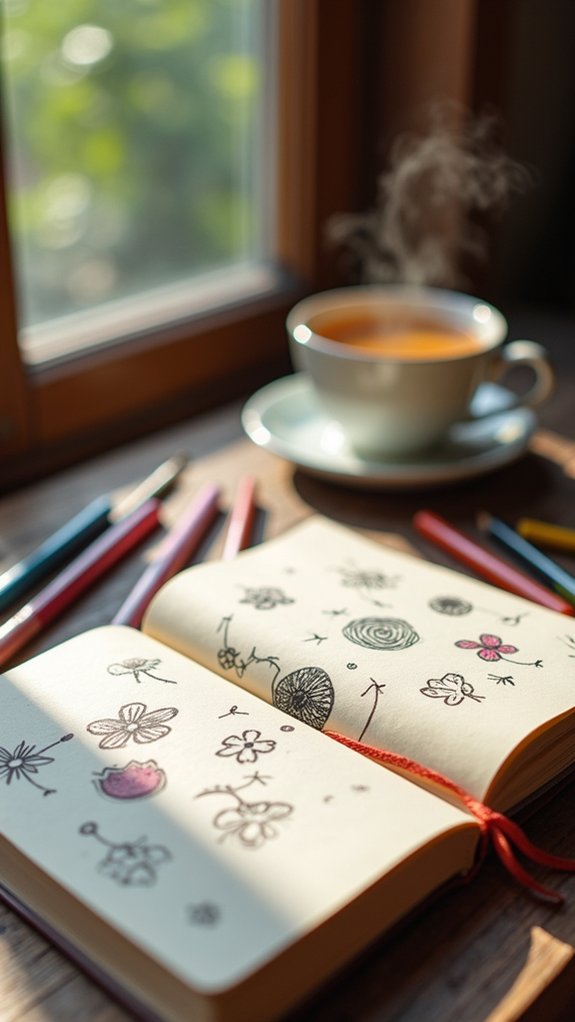
Seriously, why do so many people think they “can’t draw” in the first place? Somewhere along the way, a lot of folks start to believe that drawing means creating masterpieces that belong in museums.
But doodling actually starts with the simplest things—just lines, circles, maybe a wobbly square or an odd triangle. That’s it! There’s no secret club of “real artists,” just people who kept trying.
Practice is the magic ingredient. The more someone experiments with simple shapes, the more their confidence grows, bit by bit. If a doodle looks different than expected, that’s not wrong—it’s personal flair!
The key? Keep moving that pen and have fun. Every legendary doodler started as a beginner with shaky hands and wiggly shapes, too.
Essential Supplies for Doodle Journaling
Supplies are the secret weapons of any doodler, and having the right ones can make all the difference between a fun session and a frustrating mess. No one wants ink bleeding everywhere or a pencil that makes your hand ache! The first essential supply is a comfortable writing tool—think Pilot Dr. Grip Pencil, which keeps your doodling hand happy. For high-quality paper, a Rhodia Notepad stands out; its smooth pages save you from ghostly ink shadows. Fine liners, like Sakura Pigma Micron pens, are magical for adding details—they come in different thicknesses and don’t bleed or fade. And don’t forget a magic eraser (well, almost magic), such as the Sakura Foam Eraser, for quick, clean fixes. Here’s a quick look:
| Tool | Brand Example | Why It’s Great |
|---|---|---|
| Pencil | Pilot Dr. Grip | Super comfy for doodling |
| High-Quality Paper | Rhodia Notepad | No bleed-through, smooth |
| Fine Liners | Sakura Pigma Micron | Crisp lines, many thicknesses |
Practicing Basic Shapes and Warm-Ups
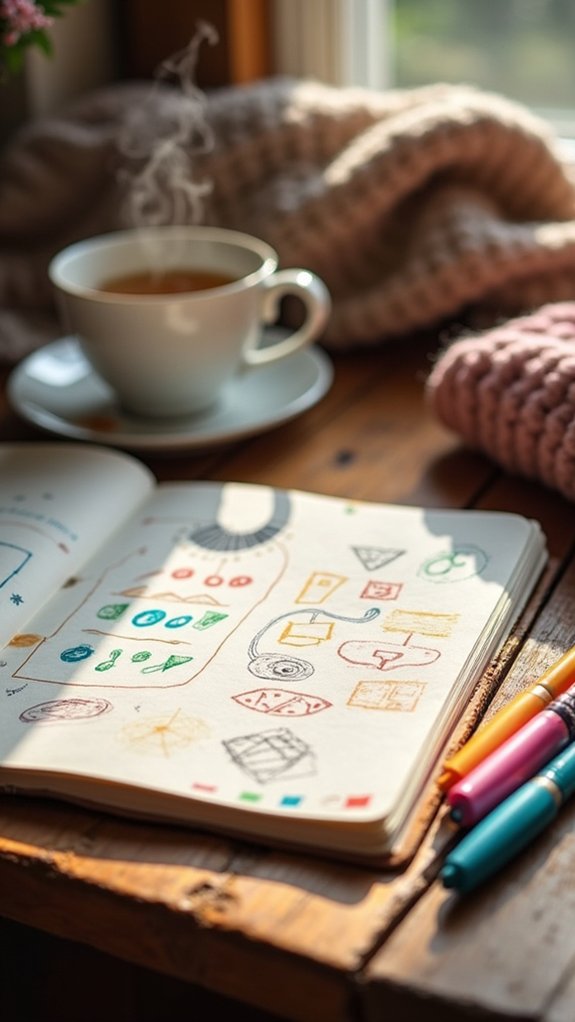
Once the perfect set of pens and journals is ready to go, most people feel this rush to draw something epic right away—but here’s the thing: no famous doodler ever skips the basics.
Practicing basic shapes and doing warm-ups might not sound thrilling, but they’re how every epic doodle begins. Just start with simple shapes—squares, circles, ovals, and triangles. They’re like the dough and sauce before you can make an awesome pizza doodle.
Warm-ups also mean trying out different line types: straight, wavy, or even dash-dot, dash-dot (Morse code, anyone?). Play with pen types, colors, and line thickness. Practicing these will boost hand control, make your lines smoother, and spark ideas.
Don’t worry about perfection—just get those hands moving!
Step-by-Step Doodling Techniques
Now it’s time to turn those warm-ups into awesome doodles, starting with basic shapes you spot in almost anything—think circles, squares, or even a slice of pizza.
By playing around with different lines, sneaking in cool details, and mixing it up with colors or wacky outlines, doodles can really pop off the page.
Get ready, because each little tweak is where the fun and magic start happening.
Basic Shape Breakdown
Although some people might feel overwhelmed by a blank page, breaking doodles down into easy shapes can make the whole process way less scary—and even a little fun.
Instead of thinking, “How do I even draw a cat?” imagine the cat as a bunch of circles, triangles, and maybe a rectangle with whiskers. Practicing these basic shapes isn’t just about doodling skills—it’s almost like giving your brain and hand a quick pep talk before diving in.
People find that when they practice doodling circles or squares over and over, their shapes start looking smoother and more like what they imagined. Remember, every wild doodle starts simple. Use your own style, and don’t be afraid to let those basic shapes turn into something completely unique!
Line and Detail Techniques
So, basic shapes are like the secret building blocks for doodles—but what happens after those circles and triangles hit the page? This is where line types and detail magic take over! Warm up with straight, wavy, dashed, and zigzag lines—think of it like stretching before a race, but for your hand. Next, turn those basic shapes into something cool by adding thicker outlines for depth and thinner lines for fun details. Want your doodles to really stand out? Shadowing techniques are your new best friend. Stippling—dotting with your pen—or using a grey marker under certain edges can make your doodles pop like they’re jumping off the page!
| Doodle Move | What It Does |
|---|---|
| Thicker Outlines | Adds depth and focus |
| Wavy or Zigzag Lines | Brings movement and fun |
| Stippling | Creates shadows, looks 3D |
| Dashed Lines | Suggests texture or borders |
Adding Color and Style
A splash of color or a bold new pattern can totally transform even the simplest doodle, turning stickers or scribbles into mini masterpieces.
Seriously, adding color isn’t just about making things pretty—it’s about bringing your doodles to life! There are loads of techniques to try, from different pen thicknesses to funky shading methods.
If you want your journal to reflect your personality, experiment with these ideas and watch your style grow:
- Use thicker pens for outer lines, and thinner ones for those tiny details—your doodles will pop instantly.
- Mix markers and colored pencils for vibrant blends. Try shading, stippling, or adding patterns to create cool textures and depth.
- Want drama? Blackout techniques using dark ink add contrast, making your bright colors stand out even more.
Styling and Personalizing Your Doodles
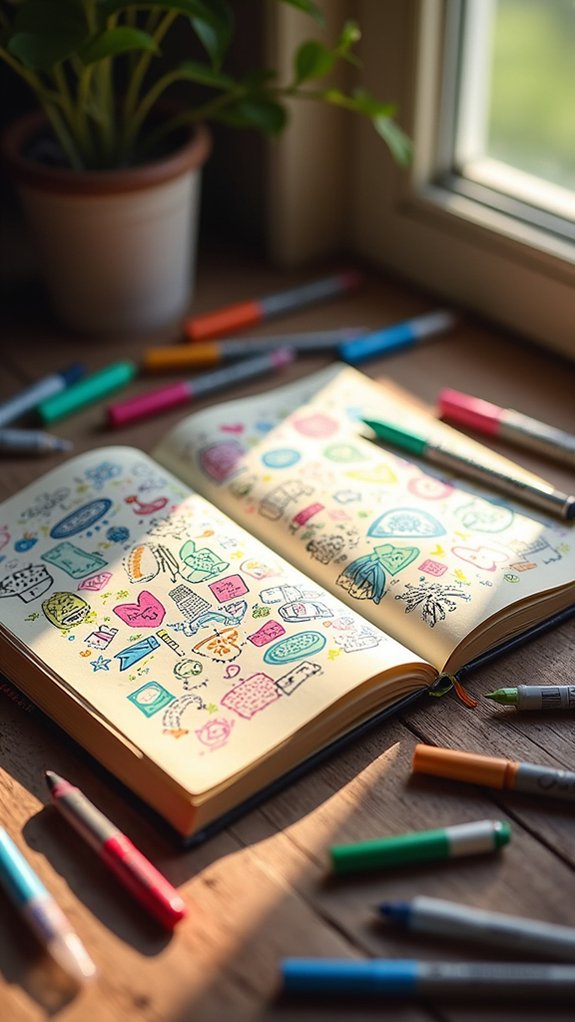
Now for the fun part—making your doodles look super cool and totally your own!
You can play around with shadows and highlights to make things pop, mix up colors for extra excitement, and pack in all sorts of funky patterns for extra flair.
Every little detail you add is a chance to show off what makes your art special (and maybe even add a secret cupcake or two, just for laughs).
Adding Shadows and Highlights
Doodle pages truly come alive when shadows and highlights join the party, making each drawing jump right off the paper.
It’s like magic—suddenly, your simple sketches look bold, three-dimensional, almost as if they’re begging for a high-five. The secret? Combining shadows, highlights, and colors creatively!
Here are a few ways to get the most out of your doodle journal:
- Master the Shadows: Pick a light source, then try using lines, dots (stippling), or a grey marker to show where the shadows fall.
- Highlight Important Spots: Grab a white gel pen or lighter marker and add highlights to simulate light reflecting off surfaces.
- Experiment With Colors: Mix in bold colors or subtle tones for even more personality—make those doodles pop!
Playing With Patterns
When it comes to making a doodle journal truly unique, playing with patterns is like opening a secret door to new worlds. Patterns transform simple doodles into eye-catching art, sparking visual interest wherever your pen wanders. Think about stripes, polka dots, or even wild chevrons—swap them in, mix and match! Vary the line thickness: bold outlines totally make shapes pop, while thin lines are perfect for teeny tiny details that amuse anyone. Add drama with the blackout technique, just fill areas in with black to create contrast. Smuggle in some texture by layering patterns, experimenting, or maybe just letting your hand wiggle across the page. Each mark tells a story!
| Pattern Type | Mood it Inspires |
|---|---|
| Zigzags | Excitement |
| Dots | Cheerfulness |
| Stripes | Energy |
| Swirls | Calm |
| Checkerboards | Playful surprise |
Experimenting With Color
A splash of color can totally change the vibe of a doodle journal page—suddenly, scribbles and shapes turn into masterpieces with attitude!
Experimenting with color is where testing out different hues and tools gets really fun and personal. Not only does it boost visual appeal, but a carefully chosen color palette can totally set the mood—think chill blues versus wild neon pinks.
Don’t be afraid to mix and match, or even break the “rules” for bold effects! Here are some easy ways to play with color:
- Try blending watercolors or colored pencils with your pens for cool textures.
- Pick a color palette—analogous colors soothe, while opposites really pop!
- Use thicker pens or vivid colors to make certain doodles stand out.
Color magic, revealed!
Creative Prompts and Inspiration Sources
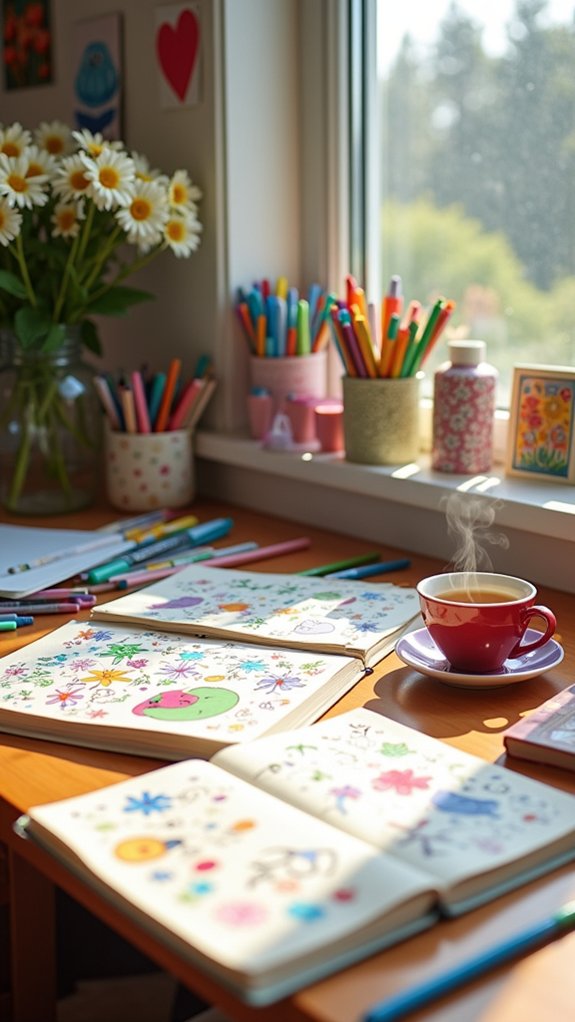
Ever wonder where creative doodlers get all their wild ideas? It’s all about finding the right creative prompts and inspiration as well.
For starters, nature is a doodler’s playground—think spring flowers, autumn leaves, or quirky snowflakes in winter.
Want to get better at doodling? Online challenges and social media trends often toss out fresh themes to try, and there’s no shame in using books or blogs packed with step-by-step doodle guides.
If a prompt says “draw your favorite snack,” go for it! You can even doodle about your mood, favorite memories, or cool hobbies—making each page uniquely yours.
With so many sources out there, starting new doodles is never boring. The more you explore prompts, the more ideas will bubble up!
Building a Consistent Doodling Habit
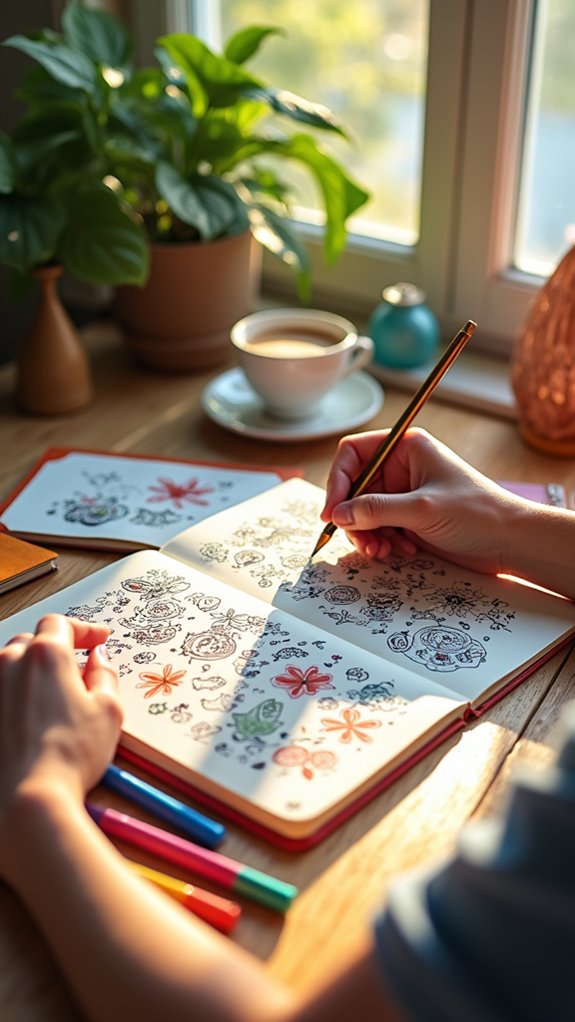
Building a consistent doodling habit might sound tricky at first, but it’s actually way more fun than it looks. The secret is to make doodling part of your daily routine—like brushing your teeth, but with more color and way less toothpaste.
Start with a dedicated doodle journal, which can turn into a treasure chest of daily doodles and creative progress. Don’t forget, doodling doesn’t have to mean hours—just five minutes a day counts!
If motivation fizzles, joining a doodling community or following online challenges can spark new ideas and keep you accountable.
Here’s a simple plan:
- Set a specific doodle time each day, even if it’s short.
- Warm up with lines or shapes to get loose.
- Use daily prompts and share with the doodling community!
Frequently Asked Questions
How Do You Start Doodling for Beginners?
To start doodling for beginners, one explores basic doodle techniques using simple shapes, engages with sketch prompts for structured practice, and seeks creative inspiration by experimenting with various tools. Guided tutorials and short timed sessions further enhance skill development.
Is Doodling in Class ADHD?
Doodling in class is not exclusive to ADHD, but research highlights doodling benefits for students with attention challenges. It can reduce classroom distraction, support memory, and provide creative expression, enhancing overall engagement and cognitive performance.
How to Doodle Journaling?
Doodle journaling involves exploring various doodle techniques, using creative prompts for inspiration, and practicing regularly. This process enhances self-expression and mindfulness, with journaling benefits including stress reduction, improved focus, and a visual record of one’s creative growth.
How to Start Bullet Journaling for Beginners?
To start bullet journaling for beginners, one selects basic bullet journaling supplies, sets up simple bullet journal layouts like Index and logs, and may join bullet journal challenges for inspiration, gradually personalizing the system for effective organization.
Conclusion
Starting a doodle journal isn’t rocket science—it’s way more fun! Anyone, even someone who thinks their stick figures need therapy, can jump in and see real improvement. With just a notebook, a pen, and a little bravery, doodling becomes a gateway to creativity and personal flair. Sure, it’s a little scary at first, but isn’t that what makes it exciting? With some practice, everyone’s doodles can become something truly awesome—and totally their own.

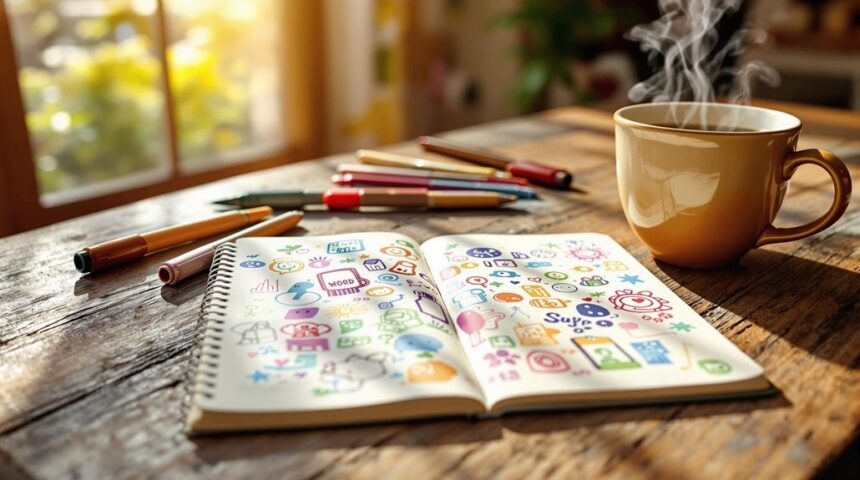
Leave a Reply